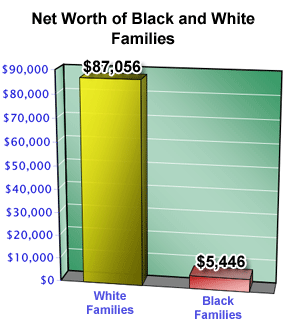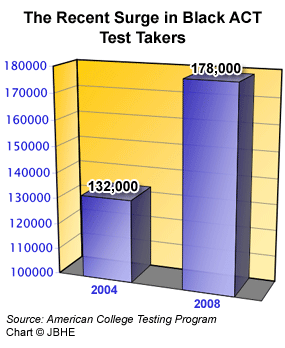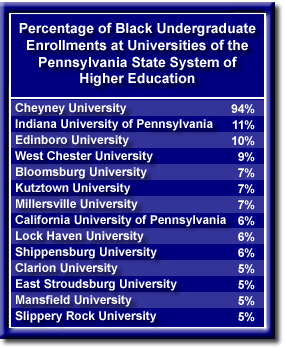Study Finds a High Degree of Wealth Volatility Among African Americans Hindering Their Ability to Pay for the Higher Education of Their Children
A very large number of African Americans are at a severe disadvantage in their ability to pay for college because of the simple fact that for the last 40 years the median black family income has remained at about 60 percent of the median white family income. But a far more important statistic for measuring the ability to finance the cost of higher education is family wealth.
Family assets such as stocks, bonds, money in the bank, and real estate produce interest, dividend, or rental income which are commonly used to offset or pay college costs. More important, these assets can be sold or borrowed against to provide funds for college expenses. In measuring family wealth, blacks come up even shorter than they do in comparison to family income. The latest data from the U.S. Census Bureau shows a median net worth for black families of $5,446. For white families the median net worth is more than 15 times larger: $87,056.

Now a new report from the Center for American Progress finds that there is a great deal of volatility for black families that have amassed some degree of wealth. The report, entitled Wealth Mobility and Volatility in Black and White, finds that only 37 percent of black children who are raised in families whose wealth ranks in the top 25 percent of all American families are themselves wealthy when they reach adulthood. Furthermore, the study found that of the African Americans who were among the top 25 percent in wealth in 1984, only 22 percent remained wealthy 20 years later.
Wide Disparity Among the 50 States in the Racial Gap Between Black and White Male High School Graduation Rates
 Last week JBHE reported the results of a new study from the Schott Foundation for Public Education which showed that 47 percent of black male students completed high school compared to 75 percent of white males. This is a racial gap of 28 percentage points. Last week JBHE reported the results of a new study from the Schott Foundation for Public Education which showed that 47 percent of black male students completed high school compared to 75 percent of white males. This is a racial gap of 28 percentage points.
But there are large differences among the 50 states. In Maine, New Hampshire, Vermont, and North Dakota, black males actually do better than white males. But in the other 46 states, as well as the District of Columbia, the black rate is below the rate for whites.
In many cases, the black male high school graduation rate is alarmingly below the rate for white males. In Wisconsin only 36 percent of black males graduate from high school compared to 87 percent of white males. This is a huge racial gap of 51 percentage points. In New York State, Illinois, Nebraska, and Michigan, the racial gap is at least 35 percentage points.

NEW YORK UNIVERSITY

Tenure-Track Position,
Department of Journalism
The Department of Journalism in the Faculty of Arts and Science at New York University invites applications for a full-time, tenure-track position at the rank of Assistant or Associate Professor to start January 1, 2009, pending budgetary and administrative approval. The Department seeks an accomplished, innovative magazine journalist with extensive current writing or editing experience. The position involves directing our field of study in Magazine Writing for a select group of graduate students, teaching both undergraduate and graduate courses, and engaging in department life. Teaching experience and substantial ties to the New York magazine publishing world are highly desirable; advanced degrees are helpful but not required. The department has particular interest in candidates with substantive, significantly researched book-length projects in development.
Send cover letter, resume or curriculum vitae and three samples of your long-form work as electronic attachments or by mail no later than September 25, 2008, to Andrea Rosenberg (andrea.rosenberg@nyu.edu or New York University, 20 Cooper Square, 6th floor, New York, NY 10003).
NYU is an Equal Opportunity/Affirmative Action Employer.

Anti-Affirmative Action Initiative Taken Off the November Ballot in Arizona
The Arizona Secretary of State Jan Brewer has removed the so-called Arizona Civil Rights Initiative from the November ballot. The measure asked voters to approve a referendum calling for the state to prohibit the consideration of race in hiring for any government position, in university admissions, or in state contracting. The referendum was supported by Arizona Senator John McCain, the Republican presidential candidate.
 Supporters of the initiative had submitted 334,735 signatures, well more than the 230,047 required to gain ballot access. But after review by the secretary of state and county officials, only 194,961 signatures were ruled valid. Supporters of the initiative had submitted 334,735 signatures, well more than the 230,047 required to gain ballot access. But after review by the secretary of state and county officials, only 194,961 signatures were ruled valid.
Supporters of the initiative now vow to go to court in an effort to win ballot access.
Similar anti-affirmative action measures are scheduled to appear on ballots in Colorado and Nebraska. Affirmative action opponents were not successful in efforts to win ballot access this year for similar proposals in Oklahoma and Missouri.
University of Georgia Enrolls the Largest Number of Black Freshmen Since 1995
 The University of Georgia reports that there are 381 black freshman students in this year’s entering class. This is the largest number of black freshmen at the University of Georgia since 1995. The University of Georgia reports that there are 381 black freshman students in this year’s entering class. This is the largest number of black freshmen at the University of Georgia since 1995.
Black students make up 7.9 percent of the entering class. Despite the recent progress, there is still considerable room for further improvement. Blacks make up 29.9 percent of the college-age population in Georgia.
There Are Almost No Black Men in the Field of Library Science
 According to a recent report from the American Library Association, there are nearly 110,000 credentialed librarians in the United States. These are men and women who have a master’s degree in library science. According to a recent report from the American Library Association, there are nearly 110,000 credentialed librarians in the United States. These are men and women who have a master’s degree in library science.
Only 19 percent of all librarians are men and fewer than 5 percent of all librarians are black. Black men make up a mere 0.5 percent of all living recipients of a master’s degree in library science. Thus, there are about 500 black male librarians in the entire nation.
Summer Enrichment Program Shown to Improve Black Students’ Chances for Success in Applying to Dental School
 Blacks make up about 6 percent of all students in the nation’s dental schools. Two of every five black dental students are enrolled at either Howard University or Meharry Medical College, two historically black schools. Blacks make up about 6 percent of all students in the nation’s dental schools. Two of every five black dental students are enrolled at either Howard University or Meharry Medical College, two historically black schools.
A new study by researchers at the University of Michigan, which was published in the Journal of Dental Education, finds that, for undergraduate students interested in pursuing careers in dentistry, a summer enrichment program can have a major positive effect on the ability of these students to gain entrance to dental school.
The research shows that after a six-week summer course the African-American college students improved their test scores on a wide range of subjects including reading, vocabulary, writing, mathematics, biology, chemistry, and physics.
The summer program was shown to improve the likelihood that these students would perform better in the college courses deemed necessary for admission to dental school and on the standardized tests required of all students who apply to dental school.
  |
16.1% Percentage of all white students who started college in 2004 who came from families whose annual income was less than $32,000.
49.1% Percentage of all black students who started college in 2004 who came from families whose annual income was less than $32,000.
source: U.S. Department of Education
|
Allen Sessoms Named President of the University of the District of Columbia
 The board of trustees of the University of the District of Columbia appointed Allen L. Sessoms as the educational institution’s new president. Dr. Sessoms had been serving as president of Delaware State University, a historically black educational institution in Dover. Previously, he was president of Queens College, part of the City University of New York system. The board of trustees of the University of the District of Columbia appointed Allen L. Sessoms as the educational institution’s new president. Dr. Sessoms had been serving as president of Delaware State University, a historically black educational institution in Dover. Previously, he was president of Queens College, part of the City University of New York system.
Dr. Sessoms is a physicist. He is a graduate of Union College and holds a master’s degree from the University of Washington and a Ph.D. in physics from Yale University.
Appointments
 • Terrell L. Strayhorn was awarded tenure and promoted to associate professor in the department of educational leadership and policy studies at the University of Tennessee. • Terrell L. Strayhorn was awarded tenure and promoted to associate professor in the department of educational leadership and policy studies at the University of Tennessee.
Professor Strayhorn is a graduate of the University of Virginia. He holds a master’s degree from the Curry School of Education at the University of Virginia and a doctorate in higher education from Virginia Tech.
 • Edward M. Willis is the new associate vice president for student affairs at Florida A&M University in Tallahassee. He was the special assistant to the president for community outreach and engagement at Owens Community College in Toledo, Ohio. • Edward M. Willis is the new associate vice president for student affairs at Florida A&M University in Tallahassee. He was the special assistant to the president for community outreach and engagement at Owens Community College in Toledo, Ohio.
Dr. Willis is a graduate of Montclair State University. He holds a master’s degree from Rutgers University and is completing his doctorate at the University of Toledo.
 • George Acquaah is the new dean of the School of Arts and Sciences at Bowie State University in Maryland. He was a professor and chair of the department of agriculture and natural resources at Langston University in Oklahoma. • George Acquaah is the new dean of the School of Arts and Sciences at Bowie State University in Maryland. He was a professor and chair of the department of agriculture and natural resources at Langston University in Oklahoma.
Acquaah, a graduate of the University of Ghana, is the author of seven college textbooks. He holds a Ph.D. from Michigan State University.
 • Jerlena Griffin-Desta was named vice president and dean of student services at Reed College in Portland, Oregon. She was executive director of student development at the University of California at Berkeley. • Jerlena Griffin-Desta was named vice president and dean of student services at Reed College in Portland, Oregon. She was executive director of student development at the University of California at Berkeley.
A graduate of Mercer University, Griffin-Desta holds a master’s degree from the University of California at Berkeley and is completing doctoral work there.
• La-Verna Fountain was appointed associate vice president for construction business services at Columbia University in New York City. She was associate vice president in Columbia’s Office of Communications and Public Affairs.
 • Stephanie Y. Mitchem was appointed director of the African-American studies program at the University of South Carolina. Since 2005 she has been an associate professor of religious and women’s studies at the university. • Stephanie Y. Mitchem was appointed director of the African-American studies program at the University of South Carolina. Since 2005 she has been an associate professor of religious and women’s studies at the university.
Dr. Mitchem is a graduate of Sacred Heart Seminary College in Detroit. She holds a Ph.D. from Northwestern University.
 • Olufemi Vaughan was named the first Geoffrey Canada Professor of Africana Studies and History at Bowdoin University in Brunswick, Maine. He was director of the College of Global Studies and associate provost at the State University of New York at Stony Brook. • Olufemi Vaughan was named the first Geoffrey Canada Professor of Africana Studies and History at Bowdoin University in Brunswick, Maine. He was director of the College of Global Studies and associate provost at the State University of New York at Stony Brook.
Dr. Vaughan holds bachelor’s and master’s degrees from St. John’s University and a Ph.D. in politics from Oxford University.
|
The Racial Gap Widens in Scores on the ACT College Entrance Examination
 The American College Testing Program reports a slight drop in the mean score for black test takers on the ACT college entrance examination. In 2008 the median score for whites on the ACT was 22.1. (The ACT test is scored on a scale of 1 to 36.) For blacks, the median score was 16.9. Since 2004 the mean score for blacks has dropped from 17.1 to 16.9. During the same period the mean score for whites has improved from 21.8 to 22.1. Therefore, the racial gap in ACT scores is widening. The American College Testing Program reports a slight drop in the mean score for black test takers on the ACT college entrance examination. In 2008 the median score for whites on the ACT was 22.1. (The ACT test is scored on a scale of 1 to 36.) For blacks, the median score was 16.9. Since 2004 the mean score for blacks has dropped from 17.1 to 16.9. During the same period the mean score for whites has improved from 21.8 to 22.1. Therefore, the racial gap in ACT scores is widening.
Officials at the testing company note that the number of test takers of all races rose by 9 percent this past year and 21 percent since 2004. The increase in black test takers has been even more pronounced, with a 17 percent rise this year alone. ACT explains that a large expansion of the testing pool will most likely lead to a reduction in the average score because many students who have not taken a rigorous high school curriculum are nevertheless applying to college and taking standardized admissions tests.

  |
“Rutgers-Newark can make a person believe they are studying abroad because of all the cultures and diversity encompassed on this campus.”
— a student at the Rutgers University campus in Newark, New Jersey, reacting to news that the university was rated by U.S. News & World Report as the most ethnically diverse national university in the United States (See story below.)
|
The Elimination of Early Admissions at the University of Virginia Does Almost Nothing to Increase Campus Diversity
 This is the first admissions cycle in which the University of Virginia did not use early decision. The university abandoned early admissions in the hope that it would help to increase both socioeconomic and racial diversity on campus. In the past, college-bound blacks and low-income students often avoided the early admission process despite the fact statistics showed that students were more likely to be admitted early than in the regular process. At least in part, blacks chose not to participate in the early admissions program because if accepted they were obliged to enroll, and this eliminated their opportunities for bargaining for a better financial aid package. This is the first admissions cycle in which the University of Virginia did not use early decision. The university abandoned early admissions in the hope that it would help to increase both socioeconomic and racial diversity on campus. In the past, college-bound blacks and low-income students often avoided the early admission process despite the fact statistics showed that students were more likely to be admitted early than in the regular process. At least in part, blacks chose not to participate in the early admissions program because if accepted they were obliged to enroll, and this eliminated their opportunities for bargaining for a better financial aid package.
Preliminary admissions figures from the University of Virginia show only a slight increase in low-income students from a year ago. Only 5.6 percent of all entering students are from what the university classifies as low-income families. Dean of admissions John Blackburn conceded, “The gains are modest but this is only the first year of the post-early decision era. We plan to continue pushing to bring in great students regardless of their economic backgrounds.”
Black enrollments dropped from a year ago. Preliminary numbers show there are 288 black freshmen in this year’s entering class. This is down from 354 black freshmen last year when the University of Virginia placed at the top of all high-ranking universities in its percentage of black freshmen. This year blacks make up about 9 percent of incoming students, down from 11 percent a year ago.
New State University Proposed in Philadelphia
 The Pennsylvania State System of Higher Education encompasses 14 university campuses from East Stroudsburg University, two miles from the New Jersey border in the east, to Slippery Rock University, on the western border of the state near Ohio. All told, this university system, which does not include the many campuses of Penn State, enrolls about 110,000 students. The Pennsylvania State System of Higher Education encompasses 14 university campuses from East Stroudsburg University, two miles from the New Jersey border in the east, to Slippery Rock University, on the western border of the state near Ohio. All told, this university system, which does not include the many campuses of Penn State, enrolls about 110,000 students.
Almost all of the 14 state universities are in rural areas far from black population centers. As a result, most have very low percentages of black students. The one exception is Cheyney University, a historically black institution.
Now John C. Cavanaugh, the new chancellor of the university system, has announced plans to open a campus of the state system in the city of Philadelphia. Blacks make up 46 percent of the city’s population. “If you bring the opportunity to the people at the right location, in the right way,” Cavanaugh said, “you can help raise the educational achievement level.”

Universities That Have Achieved Progress in the Racial Diversity of Their Athletic Programs
 Last week JBHE reported on awards given by the Laboratory for Diversity in Sport at Texas A&M University to colleges and universities that have made significant progress in their graduation rates for black athletes. Last week JBHE reported on awards given by the Laboratory for Diversity in Sport at Texas A&M University to colleges and universities that have made significant progress in their graduation rates for black athletes.
This week we report on awards given to universities that have made great overall progress in improving racial diversity in their academic programs. Universities are rated on their opportunities for black athletes as well as for the racial diversity of their coaching and administrative staffs.
The 11 winners are:
Kansas State University |
Long Beach State University |
New Mexico State University |
Pepperdine University |
Rice University |
San Jose State University |
Stanford University |
University of Colorado |
University of Hawaii |
University of Miami |
University of Texas at El Paso |

DICKINSON COLLEGE

Assistant Professor, Africana Studies
The newly established Department of Africana Studies at Dickinson College invites applications for a tenure-track assistant professor position to begin in August 2009.
We intend to hire an individual with training in Africana research applications and methodology, but we also invite applications from other appropriate areas of specialization, including Afro-Caribbean, post-colonial, black Atlantic, and African diasporic studies. A PhD is required. Teaching responsibilities will include a combination of courses in Africana research methodology and introduction to Africana Studies, and in one’s disciplinary specialization. Assistant professors with teaching experience are encouraged to apply. We hope to interview qualified applicants at the Association for the Study of African American Life and History conference (ASALH) in Birmingham, AL (Oct 1-5). Review of materials will begin September 22, but the position will remain open until filled. Candidates for this position should apply at https://jobs.dickinson.edu.
Dickinson is committed to diversity, and we encourage candidates who will contribute to meeting that goal to apply. Applications and nominations of women and minorities are strongly encouraged.

The Secret Campus of North Carolina Central University
 It was revealed earlier this month that North Carolina Central University, the historically black educational institution in Durham, had been secretly operating a satellite campus at the New Birth Missionary Baptist Church in Lithonia, Georgia, 400 miles away from the NCCU campus. The board of governors of the state university system did not know the satellite campus existed and had not approved its operation. About 50 students were still enrolled in the program when the matter came to the attention of the board of governors. Twenty-five students who were enrolled in the program received NCCU degrees. It was revealed earlier this month that North Carolina Central University, the historically black educational institution in Durham, had been secretly operating a satellite campus at the New Birth Missionary Baptist Church in Lithonia, Georgia, 400 miles away from the NCCU campus. The board of governors of the state university system did not know the satellite campus existed and had not approved its operation. About 50 students were still enrolled in the program when the matter came to the attention of the board of governors. Twenty-five students who were enrolled in the program received NCCU degrees.
New chancellor of NCCU Charlie Nelms stated that no students had been admitted to the program at the satellite campus during his tenure. James H. Ammons, now president of Florida A&M University in Tallahassee, led NCCU when the satellite campus was established.
New Birth has 25,000 members. The pastor of the church, Eddie Long, is a 1976 graduate of NCCU and currently sits on the university’s board of trustees.
U.S. News Names the Nation’s Most Racially Diverse Campuses
 This past week U.S. News & World Report issued its annual rankings of the nation’s best colleges and universities. Harvard was rated as the best university. Williams College and Amherst College tied for the best liberal arts college. This past week U.S. News & World Report issued its annual rankings of the nation’s best colleges and universities. Harvard was rated as the best university. Williams College and Amherst College tied for the best liberal arts college.
U.S. News also rates colleges and universities on the racial and ethnic diversity of their campuses. Once again, as it has for over a decade, the Rutgers University campus in Newark, New Jersey, was rated the most ethnically diverse university. Among the nearly 7,000 undergraduates on the Newark campus, only 28 percent are white. Asians are 24 percent of the student body. Blacks make up 19 percent of all undergraduate students and Hispanics are 18 percent of the student body.
For the liberal arts colleges, Pine Manor College in Chestnut Hill, Massachusetts, received the top rating for ethnic diversity. Blacks make up 41 percent of the students at this women’s college. Hispanics are 21 percent of the student body. Occidental College, the alma mater of Barack Obama, was rated the eighth most diverse liberal arts college.
Here are the 10 universities and 10 liberal arts colleges rated as the most ethnically diverse:
Universities |
Liberal Arts Colleges |
Rutgers-Newark |
Pine Manor College |
University of Houston |
SUNY-Westbury |
Nova Southeastern Univ. |
Bloomfield College |
Brooklyn Polytechnic Univ. |
Wellesley College |
Univ. of California-Riverside |
Whittier College |
Stanford University |
Swarthmore College |
Andrews University |
Univ. of Hawaii-Hilo |
N.J. Institute of Technology |
Occidental College |
Univ. of California-Los Angeles |
CalState-Monterey Bay |
University of Bridgeport |
Pomona College |
Honors and Awards
 • Bevlee Watford, associate dean for academic affairs at the Virginia Tech College of Engineering, received the 2008 Founders Award from the Women in Engineering ProActive Network. • Bevlee Watford, associate dean for academic affairs at the Virginia Tech College of Engineering, received the 2008 Founders Award from the Women in Engineering ProActive Network.
Dr. Watford holds bachelor’s, master’s, and Ph.D. degrees from Virginia Tech.
 • Edison O. Jackson, president of Medgar Evers College in Brooklyn, New York, received the Minority Access Presidential Role Model Award from Minority Access Inc., a nonprofit organization that seeks to increase racial diversity on college campuses and in the workplace. • Edison O. Jackson, president of Medgar Evers College in Brooklyn, New York, received the Minority Access Presidential Role Model Award from Minority Access Inc., a nonprofit organization that seeks to increase racial diversity on college campuses and in the workplace.
He holds bachelor’s and master’s degrees from Howard University and a doctorate in education from Rutgers University.
 • The University of Kentucky has announced that an endowed professorship will be established to honor Doris Y. Wilkinson, professor of sociology at the university. In 1958 Professor Wilkinson was the first African-American student to graduate from the university. In 1967 she was the first black woman named to a full-time faculty post at the University of Kentucky. • The University of Kentucky has announced that an endowed professorship will be established to honor Doris Y. Wilkinson, professor of sociology at the university. In 1958 Professor Wilkinson was the first African-American student to graduate from the university. In 1967 she was the first black woman named to a full-time faculty post at the University of Kentucky.
In addition to the establishment of the Doris Wilkinson Distinguished Professorship in Sociology and the Humanities, the university named a conference room in Breckenridge Hall in her honor. The building is used by the African-American studies program and the gender and women’s studies program.
Grants
• The Arkansas Department of Education has issued a $115,000 grant to fund 94 scholarships at three historically black colleges in the state. Students at Philander Smith College, Arkansas Baptist College, and the University of Arkansas at Pine Bluff are eligible for the scholarship grants.
• Florida A&M University, the historically black educational institution in Tallahassee, received a $133,820 grant from the Institute of Museum and Library Services for a program to train six graduate students in museum management and practice.
• Texas Southern University, the historically black educational institution in Houston, received a $99,000 grant from the Nuclear Regulatory Commission for a faculty development program in health physics and radiochemistry.
• North Carolina A&T State University, the historically black educational institution in Greensboro, received a $25,000 grant from the AT&T Foundation for a program that will create a Saturday academy for middle school students who will be tutored in science and mathematics. |
 .
.